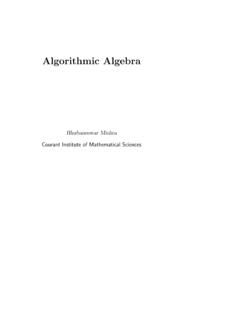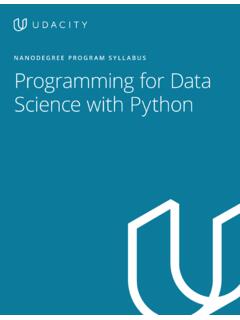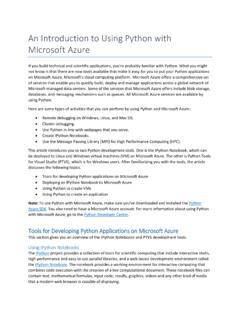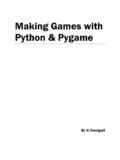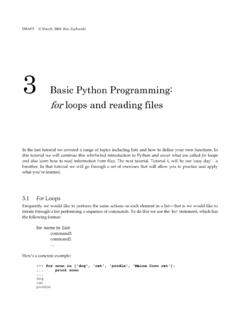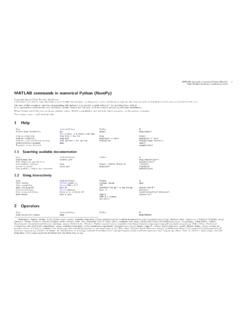Transcription of Working with Functions in Python - New York University
1 +. Working with Functions in Python Introduction to Programming - Python +. Functions +. Functions n A function is a group of statements that exist within a program for the purpose of performing a specific task n Since the beginning of the semester we have been using a number of Python 's built-in Functions , including: n print(). n range(). n len(). n (). n etc +. Functions n Most programs perform tasks that are large enough to be broken down into subtasks n Because of this, programmers often organize their programs into smaller, more manageable chunks by writing their own Functions n Instead of writing one large set of statements we can break down a program into several small Functions , allowing us to divide and conquer a programming problem +.
2 Defining Functions n Functions , like variables must be named and created before you can use them n The same naming rules apply for both variables and Functions n You can't use any of Python 's keywords n No spaces n The first character must be A-Z or a-z or the _ character n After the first character you can use A-Z, a-z, _ or 0-9. n Uppercase and lowercase characters are distinct +. Defining Functions def myfunction(): print ( Printed from inside a function ). # call the function myfunction(). +. Some notes on Functions n When you run a function you say that you call it n Once a function has completed, Python will return back to the line directly after the initial function call n When a function is called programmers commonly say that the control of the program has been transferred to the function.
3 The function is responsible for the program's execution. n Functions must be defined before they can be used. In Python we generally place all of our Functions at the beginning of our programs. +. Flow of Execution +. Flow of Execution +. Flow of Execution +. Flow of Execution +. Flow of Execution +. Flow of Execution +. Flow of Execution +. Flow of Execution +. Flow of Execution +. Flow of Execution + Flow of Execution With Functions +. Flow of Execution with Functions +. Flow of Execution with Functions +. Flow of Execution with Functions +. Flow of Execution with Functions +. Flow of Execution with Functions +. Flow of Execution with Functions +. Flow of Execution with Functions +. Flow of Execution with Functions +. Flow of Execution with Functions +.
4 Flow of Execution with Functions +. Multiple Functions +. Multiple Functions def hello(): print ( Hello there! ). def goodbye(): print ( See ya! ). hello(). goodbye(). +. Calling Functions inside Functions def main(): print ( I have a message for you. ). message(). print ( Goodbye! ). def message(): print ( The password is foo' ). main(). +. Programming Challenge: Hollow Square n Write a program that prints the pattern to the right using Functions +. Programming Challenge: User Controlled Hollow Rectangle n Ask the user for the height for a rectangle n Then draw a rectangle of that height +. Local Variables +. Local Variables n Functions are like mini programs . n You can create variables inside Functions just as you would in your main program +.
5 Local Variables def bugs(): numbugs = int(input( How many bugs? )). print (numbugs). bugs(). +. Local Variables n However, variables that are defined inside of a function are considered local to that function. n This means that they only exist within that function. Objects outside the scope of the function will not be able to access that variable +. Local Variables def bugs(): numbugs = int(input( How many bugs? )). print (numbugs). bugs(). print (numbugs) # error! Variable numbugs # doesn't exist in this scope! +. Local Variables n Different Functions can have their own local variables that use the same variable name n These local variables will not overwrite one another since they exist in different scopes . +. Local Variables def newjersey(): numbugs = 1000.
6 Print ( NJ has , numbugs, bugs ). def newyork(): numbugs = 2000. print ( NY has , numbugs, bugs ). newjersey(). newyork(). + Passing Arguments to a Function +. Passing Arguments to a Function n Sometimes it's useful to not only call a function but also send it one or more pieces of data as an argument n This process is identical to what you've been doing with the built-in Functions we have studied so far n x = (1,5) # send 2 integers n y = len( Obama') # send 1 string +. Passing Arguments to a Function def square(num): print (num**2) # num assumes the value of the # argument that is passed to # the function (5). square(5). +. Passing Arguments to a Function n When passing arguments, you need to let your function know what kind of data it should expect in your function definition n You can do this by establishing a variable name in the function definition.
7 This variable will be auto declared every time you call your function, and will assume the value of the argument passed to the function. +. Passing Multiple Arguments to a Function n You can actually pass any number of arguments to a function n One way to do this is to pass in arguments by position . +. Passing Multiple Arguments to a Function def average(num1, num2, num3): sum = num1+num2+num3. avg = sum / 3. print (avg). average(100,90,92). +. Programming Challenge n Write a function that accepts a restaurant check and a tip %. n Print out the tip that should be left on the table as well as the total bill n If the tip is less than 15% you should tell the user that they might want to leave a little more on the table +. Programming Challenge: Distance Formula n Write a program that asks the user to enter two points on a 2D plane ( enter X1 & Y1, enter X2 & Y2).
8 N Compute the distance between those points using a function. n Continually ask the user for numbers until they wish to quit +. Programming Challenge n Write a joke generator that prints out a random knock knock joke. n Extension: Write a drum roll . function that pauses the program for dramatic effect! Have the drum roll function accept a parameter that controls how long it should pause. +. Argument Mechanics +. Argument Mechanics n When we pass an argument to a function in Python we are actually passing it's value into the function, and not an actual variable +. Argument Mechanics def change_me(v): print ("function got:", v). v = 10. print ("argument is now:", v). myvar = 5. print ("starting with:", myvar). change_me(myvar). print ("ending with:", myvar).
9 +. Argument Mechanics n We call this behavior passing by value . n We are essentially creating two copies of the data that is being passed one that stays in the main program and one that is passed as an argument into our function n This behavior allows us to set up a one way communication mechanism we can send data into a function as an argument, but the function cannot communicate back by updating or changing the argument in any way n (we will talk about how to communicate back to the caller in just a second!). +. Global Variables +. Global Variables n When you create a variable inside a function we say that the variable is local to that function n This means that it can only be accessed by statements inside the function that created it n When a variable is created outside all of your Functions it is considered a global variable.
10 N Global variables can be accessed by any statement in your program file, including by statements in any function n All of the variables we have been creating so far in class have been global variables +. Global Variables name = 'Obama'. def showname(): print ("Function:", name). print ("Main program:", name). showname(). +. Global Variables n If you want to be able to change a global variable inside of a function you must first tell Python that you wish to do this using the global keyword inside your function +. Global Variables name = 'Obama'. def showname(): global name print ("Function 1:", name). name = 'John'. print ("Function 2:", name). print ("Main program 1:", name). showname(). print ("Main program 2:", name). +. Global Variables n Global variables can make debugging difficult n Functions that use global variables are generally dependent on those variables, making your code less portable n With that said, there are many situations where using global variables makes a lot of sense.
